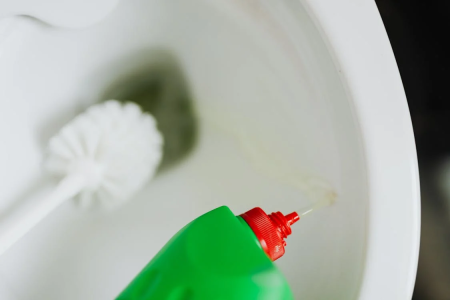You won’t believe what’s lurking on your toilet brush! Experts reveal shocking truth
By
Maan
- Replies 27
When it comes to keeping your home clean, there are a few household items that often get overlooked—one of the worst offenders being the toilet brush.
Despite its close proximity to one of the dirtiest areas in your home, most people rarely give it the attention it truly needs.
The shocking reality? It could be harboring billions of bacteria and spreading germs instead of cleaning.
In most homes, cleaning essentials like kitchen scourers, tea towels, mop heads, and dusters are replaced or cleaned regularly.
But there's one item that often gets overlooked—the toilet brush.
And it's a pretty horrifying fact that this heavy-duty cleaner can harbour up to 2.3 billion bacteria on average, a level comparable to sewer pollution.

Yet, it’s something many people rarely think to clean.
Professional cleaner Kacie Stephens from The Big Clean Co. said: ‘It sits in that poo soup liquid in the bottom of the toilet brush holder and if it’s covered in bacteria it’s not going to be cleaning your toilet but adding more germs to it.’
This thought alone might have you panicking and wondering when you last cleaned your toilet brush or if it’s time to replace it.
Here’s what you need to know.
In a social media video, Kacie shared her thoughts on this issue, sparking mixed reactions.
‘How often are you cleaning your toilet brush and toilet brush holder?’ she asked. ‘I’ve seen some pretty bad ones in my time.’
In the video, Kacie demonstrated cleaning her toilet brush and holder in the bathroom sink, explaining that you should clean your brush every time you clean the toilet.
The responses poured in with many people admitting they had never thought about cleaning their toilet brush.
Source: Tiktok/washy_wash
‘I didn’t know you should,’ said one comment.
‘It just sits in the corner and I buy a new one every time I move house.’
However, a significant debate broke out about Kacie’s cleaning method.
‘No, not in the sink!!! Why are you cleaning it in your sink?’ said one comment.
‘I clean them but I don’t clean them in the sink where I wash my teeth, that’s disgusting,’ said another.
Yet some didn’t find it as concerning.
‘Why is everyone saying “not the sink”? It’s not like she’s marinating chicken in there. And can’t you clean the sink afterwards?’ said one.
‘Calm down she will clean the sink after,’ agreed another.
Kacie responded to these concerns, saying: ‘I always clean the sink last so would completely disinfect that after cleaning the toilet brush there.’
She added that another method is to clean the brush with whatever is used to clean the toilet, then balance it between the toilet seat and rim to air dry.
There were also comments from people sharing their own methods, with some rinsing the brush in a bucket, the shower, or hosing it down outside.
Charlotte Bosanquet, a professional cleaner from Care Cleaning Services Sydney, shared her thoughts, saying that rinsing the brush isn’t enough.
‘People think if they flush and use that water to rinse off their toilet brush that’s enough but you wouldn’t wipe a bench top that had been covered in chicken and then just rinse the cloth. It’s the same thing. Rinsing with water is not cleaning it,’ she explained.
Charlotte recommended soaking the brush in bleach every 6 weeks, or even more frequently, depending on usage.
Cleaning your toilet brush regularly is essential.
When it comes to replacing your toilet brush, it’s really not complicated.
When it’s dirty and starts showing signs of mould, it’s time to toss it out.
‘I’d say every 6 months you should get a new one,’ Charlotte said, while Kacie suggested replacing it annually.
But neither professional cleaners favoured pricey toilet brushes.
‘I’m not a fan of the silicon brushes. They’re my worst nightmare—they don’t get the grime off,’ Charlotte said.
‘The ones with bristles are the best. The $5 ones from Woolies are great.’
Kacie agreed, saying: ‘The silicon paddle ones look nice in your bathroom but they are very difficult to use to clean the toilet. I’d go bristles every time.’

Now that you know just how important it is to keep your toilet brush clean, how often do you clean yours? Let us know in the comments!
Despite its close proximity to one of the dirtiest areas in your home, most people rarely give it the attention it truly needs.
The shocking reality? It could be harboring billions of bacteria and spreading germs instead of cleaning.
In most homes, cleaning essentials like kitchen scourers, tea towels, mop heads, and dusters are replaced or cleaned regularly.
But there's one item that often gets overlooked—the toilet brush.
And it's a pretty horrifying fact that this heavy-duty cleaner can harbour up to 2.3 billion bacteria on average, a level comparable to sewer pollution.

Forgotten household item harbours shocking bacteria levels. Image source: Pexels/Photo By: Kaboompics.com
Yet, it’s something many people rarely think to clean.
Professional cleaner Kacie Stephens from The Big Clean Co. said: ‘It sits in that poo soup liquid in the bottom of the toilet brush holder and if it’s covered in bacteria it’s not going to be cleaning your toilet but adding more germs to it.’
This thought alone might have you panicking and wondering when you last cleaned your toilet brush or if it’s time to replace it.
Here’s what you need to know.
In a social media video, Kacie shared her thoughts on this issue, sparking mixed reactions.
‘How often are you cleaning your toilet brush and toilet brush holder?’ she asked. ‘I’ve seen some pretty bad ones in my time.’
In the video, Kacie demonstrated cleaning her toilet brush and holder in the bathroom sink, explaining that you should clean your brush every time you clean the toilet.
The responses poured in with many people admitting they had never thought about cleaning their toilet brush.
Source: Tiktok/washy_wash
‘I didn’t know you should,’ said one comment.
‘It just sits in the corner and I buy a new one every time I move house.’
However, a significant debate broke out about Kacie’s cleaning method.
‘No, not in the sink!!! Why are you cleaning it in your sink?’ said one comment.
‘I clean them but I don’t clean them in the sink where I wash my teeth, that’s disgusting,’ said another.
Yet some didn’t find it as concerning.
‘Why is everyone saying “not the sink”? It’s not like she’s marinating chicken in there. And can’t you clean the sink afterwards?’ said one.
‘Calm down she will clean the sink after,’ agreed another.
Kacie responded to these concerns, saying: ‘I always clean the sink last so would completely disinfect that after cleaning the toilet brush there.’
She added that another method is to clean the brush with whatever is used to clean the toilet, then balance it between the toilet seat and rim to air dry.
There were also comments from people sharing their own methods, with some rinsing the brush in a bucket, the shower, or hosing it down outside.
Charlotte Bosanquet, a professional cleaner from Care Cleaning Services Sydney, shared her thoughts, saying that rinsing the brush isn’t enough.
‘People think if they flush and use that water to rinse off their toilet brush that’s enough but you wouldn’t wipe a bench top that had been covered in chicken and then just rinse the cloth. It’s the same thing. Rinsing with water is not cleaning it,’ she explained.
Charlotte recommended soaking the brush in bleach every 6 weeks, or even more frequently, depending on usage.
Cleaning your toilet brush regularly is essential.
When it comes to replacing your toilet brush, it’s really not complicated.
When it’s dirty and starts showing signs of mould, it’s time to toss it out.
‘I’d say every 6 months you should get a new one,’ Charlotte said, while Kacie suggested replacing it annually.
But neither professional cleaners favoured pricey toilet brushes.
‘I’m not a fan of the silicon brushes. They’re my worst nightmare—they don’t get the grime off,’ Charlotte said.
‘The ones with bristles are the best. The $5 ones from Woolies are great.’
Kacie agreed, saying: ‘The silicon paddle ones look nice in your bathroom but they are very difficult to use to clean the toilet. I’d go bristles every time.’
Key Takeaways
- Toilet brushes can harbour billions of bacteria and are often forgotten in regular cleaning routines.
- Experts recommend cleaning the toilet brush every time you clean the toilet to prevent germ spread.
- Cleaning methods sparked debate, especially over whether it’s acceptable to use the sink.
- Brushes should be disinfected regularly and replaced every 6–12 months, with bristle brushes preferred.
Now that you know just how important it is to keep your toilet brush clean, how often do you clean yours? Let us know in the comments!







